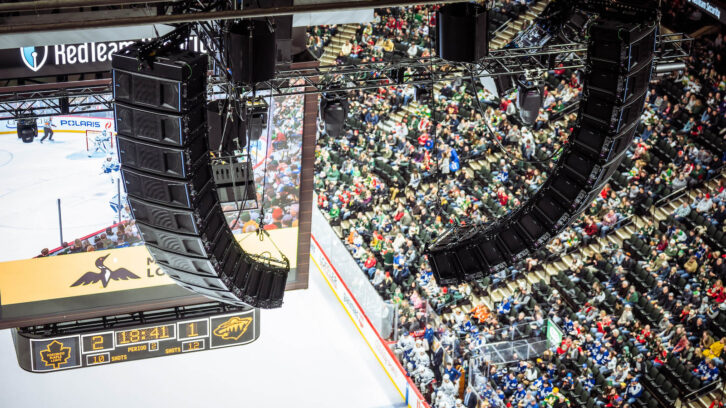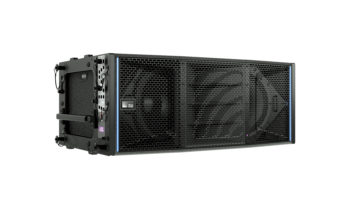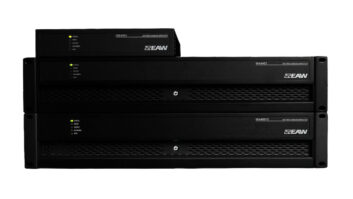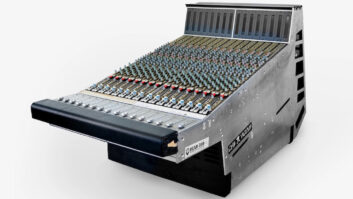
St. Paul, MN (January 6, 2023)—The crowd can get pretty raucous at Minnesota Wild games inside the NHL team’s home arena, Xcel Energy Center in Saint Paul. Now ensuring that the crowd can hear every call and exultant cry of “Goal” is a brand-new reinforcement system centered around 96 Meyer Sound Panther large-format linear line array loudspeakers. Designed and installed by Sound Associates of Yonkers, New York, the world’s largest Panther installation to date debuted on November 1, 2022 when the Wild defeated the Montreal Canadiens 4–1.
The new Meyer Sound system replaced an aging point-source system that was installed when the 18,000-seat arena first opened in 2000. “We are highly impressed by the way our new Meyer Sound system delivers clear and uniform sound distribution to fans throughout the Xcel Energy Center,” said Minnesota Wild president Matt Majka. “No matter where you are sitting in the arena, the improvement in audio quality is undeniable. Feedback from event attendees has been tremendous. We are extremely pleased with our decision to install a state-of-the-art system to heighten the experience for our fans.”
“What we had was a low-bid system with old technology,” says Jim Pfitzinger, the IATSE Local 13 engineer who has mixed Wild games since the arena opened and who was a key consultant on the upgrade project. “Top team management had heard systems at newer arenas and noticed the difference. Our old system was still intelligible and serviceable, but it lacked real impact. No matter how hard you flogged it, you could only get so much out of it.”
Ghost Rolls Out with Ultrasound and Meyer Sound
In the spring of 2022, management asked Pfitzinger to fast-track a new, state-of-the-art system; he, in turn, consulted with Domonic Sack of Sound Associates on possible options at a time when industry supplies were tight. Some makers could not commit to delivering the preferred products on the tight timeline, but Meyer Sound was able to fit the Wild project into its production schedule. In only 11 days, the entire system was wired, hung, and tuned, just in time for the first Minnesota Wild game with the new system.
“Dom had just heard Meyer Sound’s Panther demo in Las Vegas and said he was convinced it was the right solution for this arena,” says Pfitzinger. “We wanted line arrays with a small footprint to stay clear of touring rock shows, plus low power consumption and reduced weight. Powered speakers were high on the list as we had literally tons of amplifiers and copper cables in the ceiling and we couldn’t take them out until the new system was up and running. Also, everything had to go up and down on the motors.”
Using the MAPP 3D system design and prediction tool, the design particulars were worked out by Sack in consultation with Meyer Sound director of system optimization Bob McCarthy and design services supervisor Alex Harbaugh. As installed, the system comprises eight hangs of 12 each Panther loudspeakers, all with the 80-degree L horn. There are also dual hangs of nine each 1100-LFC low-frequency control elements in cardioid configurations. The entire system is networked for control, monitoring, and audio signal using the Milan AVB protocol, with redundant analog backup.
Two other key members of the project team were Metropolitan Interactive, responsible for rigging design under the guidance of Jeff Mele; and Geiger Engineering, responsible for assuring the structural integrity of all rigging points. Members of IATSE Local 13 were charged with the final rigging and flying of the system.
“The response to the new system has been overwhelmingly positive,” reports Pfitzinger. “I now have no problem lifting announcer Adam Abrams over the crowd noise; where before he was often buried, now it’s effortless. Nothing ever sounds pushed or distorted. It has clarity and impact, yet even when the music is up you still can carry on a conversation. And there is an incredible difference in the voice quality and clarity of the referee microphones.”







